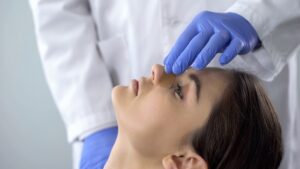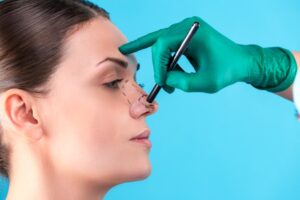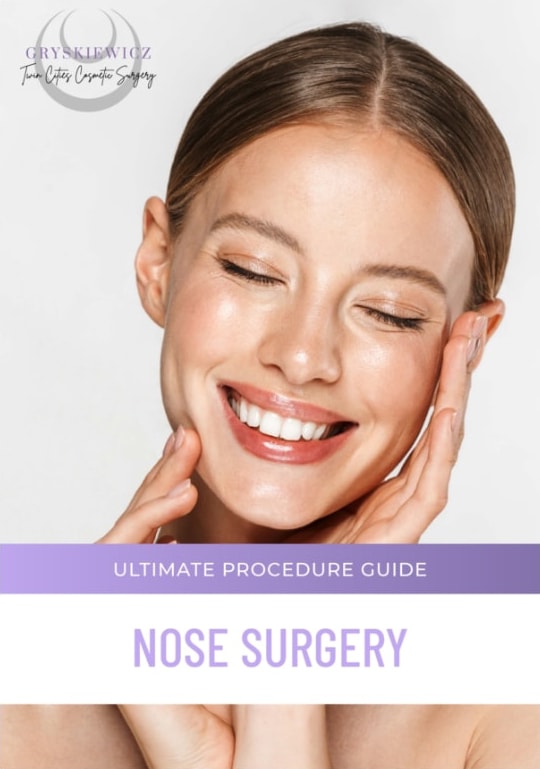Nose Shapes after Rhinoplasty – Exploring the Most Common Nose Shapes Achievable Through Rhinoplasty
Written By Joe Gryskiewicz, MD, FACS
Rhinoplasty, commonly known as a nose job, is a cosmetic surgical procedure that aims to reshape and improve the appearance of the nose. While the procedure is primarily performed for cosmetic reasons, it can also be done to correct functional issues such as breathing difficulties. One of the most common concerns among those considering rhinoplasty is the potential change in the shape of their nose after the procedure. It’s essential to understand that every patient’s results are unique, and the shape of the nose after rhinoplasty will depend on several factors.
Minnesota plastic surgeon Dr Joe Gryskiewicz specializes in nose surgery and can assist you in achieving your desired nose shape through a rhinoplasty procedure.
Factors Affecting Nose Shape after Rhinoplasty
- Preoperative nose shape: The starting shape of the nose plays a significant role in determining the final result of rhinoplasty. Patients with more significant deformities or asymmetries may require more extensive surgery to achieve their desired outcome;
- Surgical technique: The surgical technique used during rhinoplasty can also affect the shape of the nose after the procedure. Surgeons use different techniques, such as open or closed rhinoplasty, to achieve specific outcomes. Open rhinoplasty involves making a small incision on the outside of the nose, allowing the surgeon to have better visibility and access to the nasal structures. Closed rhinoplasty involves making incisions on the inside of the nose, making it a more conservative approach;
- Healing process: The healing process is crucial in determining the final shape of the nose after rhinoplasty. Swelling and bruising are common after the procedure, and it can take several weeks or even months for the swelling to subside. During this time, the nose can appear more prominent or have a different shape than expected. The body’s natural healing process can also significantly affect the final result;
- Skin thickness: The thickness of the skin on the nose can also play a role in the final shape after rhinoplasty. Patients with thick skin may not see the same level of refinement as those with thinner skin.
Common Nose Shapes after Rhinoplasty

-
Straight nose
A straight nose is one of the most common nose shapes achieved through rhinoplasty. This shape is characterized by a straight nasal bridge, creating a more symmetrical and balanced appearance. Patients who desire a straight nose may have a nasal hump or deviation, which can be corrected through surgery.
The surgical technique used to achieve a straight nose depends on the patient’s unique anatomy and goals. Generally, the surgeon will remove any excess cartilage or bone from the nasal bridge, creating a smooth and straight line. They may also use grafts to help support the nose’s structure and prevent collapse.
A straight nose is a versatile shape that can complement a variety of facial features. It can make the face appear more balanced and harmonious, improving overall facial aesthetics. Patients who desire a straight nose should consult with a qualified and experienced plastic surgeon to determine the best approach to achieve their desired outcome.
-
Upturned nose
An upturned nose is a nose shape that has a slight lift at the tip, giving it a more youthful and feminine appearance. This shape is often desired by patients who feel their nose appears too long or droopy. The nose lip angle should be about 98 degrees, more for shorter women, and less for taller women. Men should be at 90 degrees.
To achieve an upturned nose, the surgeon will adjust the nasal tip during surgery. They may use sutures to lift the tip and create a more defined angle between the nose and upper lip. The surgeon may also use cartilage grafts to provide support and create a natural-looking tip.
An upturned nose can complement a variety of facial features, particularly those with a small or narrow face. It can create a more balanced and youthful appearance, improving overall facial aesthetics. It’s also important to note that an upturned nose may not be suitable for everyone. Patients with a longer face or a prominent chin may not benefit from an upturned nose as it can further emphasize these features. A skilled surgeon can assess each patient’s unique facial features and recommend the most appropriate nose shape for their facial anatomy.
-
Narrow nose
A narrow nose is another common nose shape that patients can achieve through rhinoplasty. This shape is characterized by a reduced width of the nose, creating a more refined and elegant appearance.
To achieve a narrow nose, the surgeon will carefully remove excess bone and cartilage from the nasal bridge. The surgeon may also use cartilage grafts to create a more defined and structured nose. The goal of the procedure is to create a balanced and proportional nose that complements the patient’s facial features.
A narrow nose can complement a variety of facial shapes, particularly those with a wider face or broader features. It can make the face appear slimmer and more balanced, improving overall facial aesthetics.
It’s essential to understand that a narrow nose may not be suitable for every patient. Patients with thin or delicate skin may not achieve the same level of refinement as those with thicker skin.
-
Natural-looking nose
A natural-looking nose is a nose shape that blends seamlessly with the rest of the face, creating a balanced and harmonious appearance. This shape is often desired by patients who want to improve the appearance of their nose while maintaining a natural look.
To achieve a natural-looking nose, the surgeon will carefully consider the patient’s facial features and create a nose shape that complements them. The surgeon will focus on creating a balanced and proportional nose that does not appear too small or too large for the patient’s face. The goal is to achieve a nose shape that looks like it belongs to the patient and is not obvious or artificial-looking.
A natural-looking nose can complement a variety of facial features and is often the most desired nose shape among patients. It can improve overall facial aesthetics and boost self-confidence.
It’s important to note that some patients may desire a more dramatic change in their nose shape or have specific aesthetic goals that do not align with a natural-looking nose.
Rhinoplasty is a cosmetic surgical procedure that can improve the appearance of the nose and correct functional issues. The shape of the nose after rhinoplasty will depend on several factors, including the patient’s unique anatomy, surgical technique, and healing process. Patients can achieve several nose shapes after rhinoplasty, including straight, upturned, narrow, and natural-looking noses. It’s crucial to discuss your goals and expectations with your surgeon to ensure that you achieve the desired outcome.
FAQs about Nose Shapes after Rhinoplasty

What is the most desired nose shape?
The most desired nose shape varies among individuals and can be influenced by cultural and societal beauty standards. However, studies have shown that a natural-looking nose is often the most desired nose shape among patients seeking rhinoplasty. This nose shape blends seamlessly with the rest of the face, creating a balanced and harmonious appearance. It is typically characterized by a straight or slightly curved nasal bridge, a defined nasal tip, and nostrils that are proportionate to the nose. While a natural-looking nose is the most desired nose shape, it’s important to remember that every patient’s desired outcome and anatomy are unique.
What is the most common female nose shape?
There is no one “most common” female nose shape, as nose shapes can vary greatly among individuals. However, some research has suggested that a smaller, slightly upturned nose with a straight bridge and a defined tip is often considered attractive in many cultures. That being said, it’s important to remember that there is no one-size-fits-all approach to nose shape, and what is considered attractive can vary depending on individual preferences and cultural norms. Patients seeking rhinoplasty should work closely with a qualified and experienced plastic surgeon to determine the best approach to achieve their desired outcome while maintaining a natural-looking appearance that complements their unique facial features.
What to expect 3 months after rhinoplasty?
Three months after rhinoplasty, patients can expect to see significant improvement in the appearance of their nose, although the final result will not yet be fully apparent. At this stage, most of the swelling and bruising should have subsided, allowing patients to see more clearly how their nose is taking shape. Here are some general things that patients can expect three months after rhinoplasty:
- Swelling: While most of the swelling should have subsided by this point, some residual swelling may still be present, particularly in the tip of the nose. It’s important to continue following the surgeon’s post-operative instructions to minimize swelling and promote proper healing;
- Breathing: Patients may still experience some temporary breathing issues due to swelling or nasal congestion, but these should continue to improve over time;
- Appearance: Patients should notice a significant improvement in the appearance of their nose at this stage, although the final result will not be fully apparent yet. The nose should look more balanced and proportionate to the rest of the face;
- Activities: Patients will have resumed allnormal activities and exercise routines, includinghigh-impact and strenuous activities.
Can you choose the shape of your nose in rhinoplasty?
Yes, your surgeon may use computer imaging software to show you a simulated image of what your nose could look like after the surgery. This can help you make an informed decision about your desired nose shape. It’s important to remember that while patients can choose the shape of their nose, there are limitations to what is achievable based on the patient’s facial anatomy and other factors. You should have realistic expectations about the final result and be prepared to communicate openly with your surgeon throughout the process.
How do I know what nose shape to get?
 Here are some factors to consider when deciding on the shape of your nose after rhinoplasty:
Here are some factors to consider when deciding on the shape of your nose after rhinoplasty:
- Facial features: The shape of the nose should complement the patient’s other facial features, such as the eyes, cheeks, and chin;
- Aesthetic goals: You should have a clear understanding of their desired outcome and communicate this openly with your surgeon. Your surgeon will provide guidance on what is achievable based on your unique facial features and provide recommendations on the most appropriate nose shape. Bring in “Wish pictures;
- Skin type: The thickness and quality of the skin can affect the final result of the surgery. Patients with thicker skin may not achieve the same level of refinement as those with thinner skin;
- Surgical technique: The specific surgical technique used can affect the final result. Patients should choose a qualified and experienced plastic surgeon who can provide guidance on the best approach to achieve the desired outcome while maintaining a natural-looking appearance;
- Realistic expectations: It’s important to have realistic expectations about the final result and understand that the shape of the nose after rhinoplasty can depend on several factors, including the patient’s unique anatomy, surgical technique, and healing process.
Further Reading about Rhinoplasty
Read Dr Joe’s blog aboutSurgery for a Smaller Nose
Read Dr Joe’s blog about Best Rhinoplasty for a Bulbous Nose
Read Dr Joe’s Rhinoplasty Surgery Page
Read Dr Joe’s blog about Different Types of Nose Shapes
Visit our Rhinoplasty Gallery
Medical References about Rhinoplasty
What to know about rhinoplasty – Medical News Today
Rhinoplasty Surgery page – WebMD
Rhinoplasty (Nose Job): Surgery, Recovery, Before & After – Cleveland Clinic



